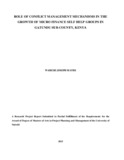| dc.description.abstract | Micro-finance groups are faced with numerous challenges some of which inhibits both their existence and effectiveness especially when it comes to meeting the member’s needs. Interpersonal conflicts are universally present in human relations and become especially visible in group psychotherapy. The high growth of microfinance groups has been attributed to improved cooperation and group cohesion which implies better conflict resolution mechanisms. It is apparent that groups have been employing advanced conflict management mechanisms. This study investigates various conflict management mechanisms used by microfinance groups and the effectiveness of these mechanisms in realizing cohesion and ultimately achieving growth in groups. The study sought to assess the role of competition as a conflict management mechanism in the growth of micro finance self-help groups; to establish the role of collaboration as a conflict management mechanism in the growth of micro finance self-help groups; to determine the role of compromise as a conflict management mechanism in the growth of micro finance self-help groups; to establish the role of avoidance as a conflict management mechanism and growth of micro finance self-help groups; to assess the role of accommodating as a conflict management mechanism in the growth of micro finance self-help groups. The study was a descriptive study targeting microfinance groups in Gatundu District of Kenya. This included women groups, youth groups, community support groups that deal with financial aspects only. Stratified random sampling technique was used to select 87 respondents 60 of which were members, 12 SHGs group officials, 9 Ex-officials and 6 Government officials. Questionnaires were filled by drop and pick method after which the raw data was coded, edited, sorted and classified. Both qualitative and quantitative data was analyzed using the Statistical Package for Social Scientists (SPSS) to compute frequency tables as well as contingency tables for presentation of the variables under study. The study found that competing is used as a conflict management mechanism. From the findings, it was found that the best way of handling conflicts was by high assertiveness and low cooperation, taking a firm stand and aiming to win. The study found that collaboration is used as a conflict management mechanism in microfinance groups. The study found that the groups are culturally heterogeneous and expected to display types of behavior and interactions that are different from those displayed by a culturally homogeneous group. The study found that compromising is used as a conflict management mechanism and growth of microfinance groups. Group members and officials mostly compromise to side step a conflict for a temporary solution or attain middle ground position. The study found that avoiding conflict is mainly used as a conflict management mechanism. It was found that people with low concern for self and for others had little desire to solve the problem at all. The study found that accommodating is used as a conflict management mechanism in growth of microfinance groups. High assertiveness and high cooperation meet the needs of all people involved and aim to work with other people and win-win situation is mainly used as an accommodation method. | en_US |

